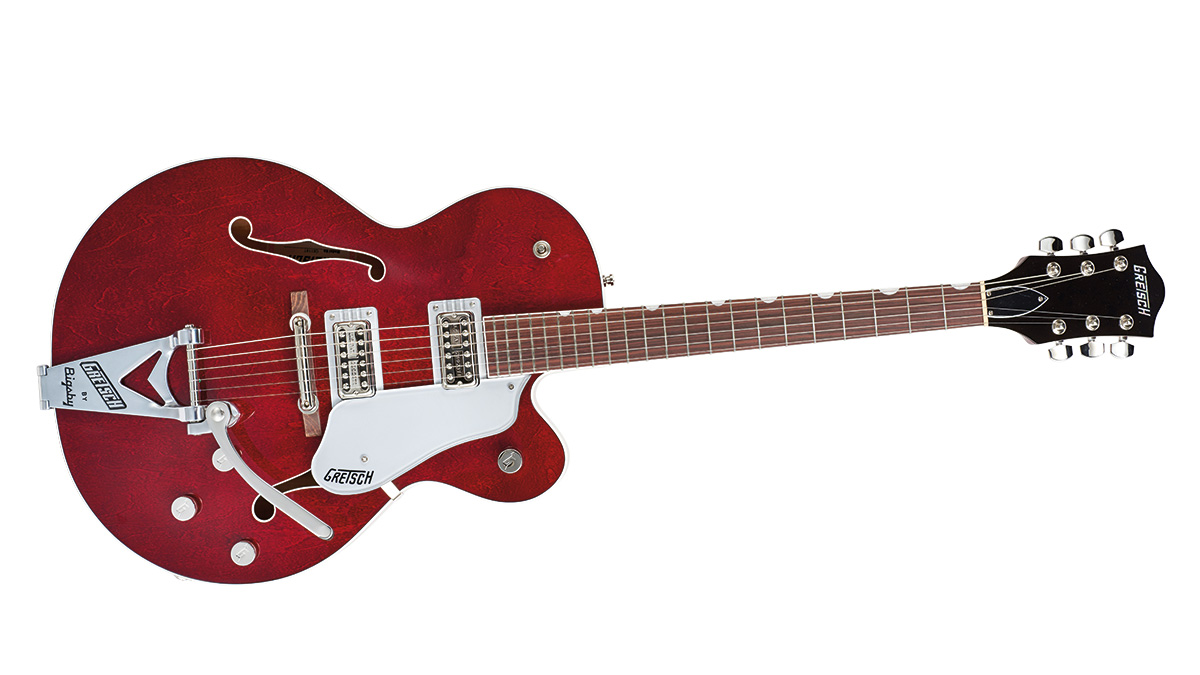MusicRadar Verdict
Beautifully made and with some lovely period-correct details mixed with more modern concessions, there's little we don't like here.
Pros
- +
Great upgrades, including the locking tuners and String-Thru Bigsby
Cons
- -
A very close cousin to the Anniversary... a model too far?
MusicRadar's got your back
The Tennessee Rose is a dead ringer for the recently-released Anniversary, with the exception of the more conventional Deep Cherry Stain finish and clean white fingerboard binding that matches the body's binding.
It features 'ML' bracing, pinned Rocking Bar bridges, 'string-thru' Bigsbys, strap locks, locking tuners and Tusq XL nut, Squeezebox caps, a treble-bleed circuit, No-Load tone pots and thinner 2.25-inch body.
The chrome/nickel hardware is mirrored by the silver back-sprayed pickguard. It's a straightforward, modern player for the journeyman guitarist who doesn't want to upstage the singer - never a good idea if you want to keep your gig!
There are a lot of similarities with Fender's Telecaster and the sound we hear from the 6120: a quite steely bridge, soft mellow neck and a percussive mix that, as soon as you drop into a basic Chet Atkins-like picking pattern, produces a rubbery thwack to the basses with a hollowed textured bite from the high strings - glorious and hugely evocative.
While it's true that Mr A might not have liked these DeArmonds, the entire sonic stew moves through the decades, just like a Tele - it ain't just for country!
That mix, for example, is a superb soul voice and the dynamic range of the instrument... well, it's why many of us are so drawn to hollowbodies and semis. The aesthetic might not be right, but you can easily cover your jazz deps with this, too, although the neck has a slightly soft-nosed attack on the upper strings and real high- fret access isn't that easy.
But, in anyone's book, it's just a quality voice with a slightly short old-school sustain and that hollowbody snap. Aside from the mix-pickup position, hum may be problematic on the solo pickups - they are single coils, after all.
Want all the hottest music and gear news, reviews, deals, features and more, direct to your inbox? Sign up here.
The bigger body of the White Falcon is noticeable seated, slightly less so strapped on, but it feels a little more solid and chunky. The perception of its sound is that it's slightly more forceful, a little higher in output, stronger and firmer, helped by the longer scale length.
The tone switch is a very neat circuit that simply offers a slight high-end roll off when pushed up, and a darker, throatier sound when pushed down.
On a big guitar like this, not least with the Bigsby in play, those standard controls seem quite a way away, so you can set your individual volumes then control everything from the top of the guitar: master volume (which seems to retain the highs as it's reduced, while them individual volumes slightly soften the attack when reduced), pickup selection and tone control. The feedback threshold is raised, but it still remains, despite the firmer structure, essentially a hollowbody.
The Anniversary and the Tennessee Rose, on paper, are the same guitar and plugging in the Anniversary after the Falcon takes us slightly further still from the 6120. With everything full up, we feel the need to add a little treble from our amp to create that stingin' steely tone from the bridge, while both the mix and the neck sound a little clouded, a little thicker than the Falcon.
Of the two, it might be splitting hairs a little, but the Tennessee Rose just sounded a little lighter, especially on the mix and the neck pickup positions. Certainly, when we've tested the No-Load tone fully open on a Fender solidbody, we quite often back it off. Here, we kept it pretty much fully up. Gretsches for the more contemporary-minded player? Quite definitely.
Dave Burrluck is one of the world’s most experienced guitar journalists, who started writing back in the '80s for International Musician and Recording World, co-founded The Guitar Magazine and has been the Gear Reviews Editor of Guitarist magazine for the past two decades. Along the way, Dave has been the sole author of The PRS Guitar Book and The Player's Guide to Guitar Maintenance as well as contributing to numerous other books on the electric guitar. Dave is an active gigging and recording musician and still finds time to make, repair and mod guitars, not least for Guitarist’s The Mod Squad.

